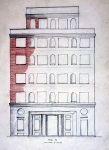THE TWENTIES: THE CLASSICAL CONVERSATION
Gio Ponti was an architect who started out with ceramics. It should be said straightaway: being an architect was not one aspect of his versatility, versatility was one aspect of his being an architect, owing to the all-encompassing sense that he gave to architecture: in each different thing there is always the same process and the same hand…Right from the start, he got involved in both design and promotion. He was not afraid of luxury or of mass production. For quality lies in form, and it can be spread around. Indeed, it has to be. And at once. These were the roots of both his enthusiasm and his detachment.
This can be seen in his first major assignment: from 1923 to 1930 the young Ponti was art director of the Richard-Ginori factory, and he made a complete change in its output. The famous Grand Pieces, as well as the minor ones, of the Ponti period at Richard-Ginori were all inspired by the idea of quality in industrial production. Industry is the style of the 20th century, its mode of creation… wrote Ponti in the catalogue of the Paris Expo, 1925, where his porcelain won the Grand Prix.
Thus the luxury furniture that Ponti designed in these years was paralleled by his low-cost furniture for the department store La Rinascente, the «Domus Nova series, 1927. And he would show both kinds (his own pieces and those of other designers) at the great exhibitions of the time the Venice Biennale and Triennale in Monza. Industry, mass production, distribution, advertising, exhibitions, magazines. An exciting sequence, at that time. Ponti brought the art industries into contact with each other (Christofle with Venini). He got architects and manufacturers to go into partnership (in il Labirinto,1927). He presented designers and designs in the exhibitions he staged. He published them in the magazine he founded. The magazine was Domus. It was born, in 1928, at the suggestion of the great journalist Ugo Ojetti, the Florentine patron of the young Ponti in those years. Later they would courteously drift apart. It was set up almost as a joke, as a Milanese improvisation; and was to remain such. It was, at the outset, a vehicle for Italian neoclassical domestic culture, and Ponti used it to fight his battles: almost won, against the fake antique and still to be won, against the ugly modern. The publisher was Gianni Mazzocchi, even younger than Ponti - they were to work together for years.
Ponti met the applied arts first, before architecture. His first house in Milan, the one on Via Randaccio, dates from 1925. It was immediately followed by his first construction abroad, the Villa Bouilhet at Garches, Paris. They are his two most typical works of architecture: the roots of their design are neoclassical, their layout innovative. We say neoclassical today. Ponti would say of classical inspiration, owing to the enormous impression made on me by living, while resting from the front during the war, in buildings by Palladio, and seeing as many of them as I could. It was a non-programmatic starting point which was never to disappear, even though the forms did vanish. During these years, from 1926 to 1933, Ponti was in partnership with the architect Emilio Lancia.
From "Gio Ponti, l'opera" by Lisa Licitra Ponti,1990, Leonardo Editore



















